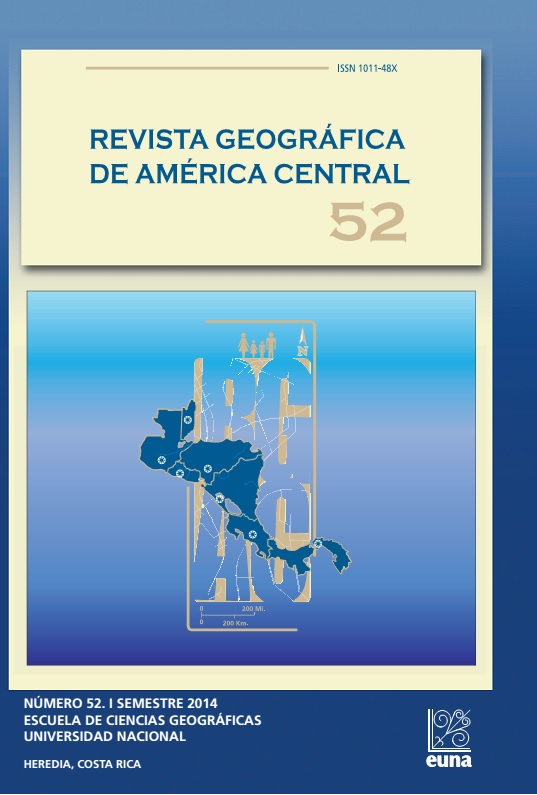ANALYSIS OF SEISMIC ACTIVITY IN COSTA RICA DURING 2010 AND SUMMARY OF MAJOR SEISMIC EVENTS IN COSTA RICA FROM 1983 TO 2012
Keywords:
Seismicity in 2010, Earthquake Location, Tectonic Plates, Major EarthquakesAbstract
The goal of this work is to analyze the seismic activity recorded by the OVSICORI-UNA seismic network in 2010; we also gathered information of the main events felt since 1984. The earthquake location is made using P- and S- arrivals, and source parameters are characterized using polarities and waveforms. The subduction process of the Cocos tectonic plate beneath the Caribbean one caused two important earthquakes of magnitudes 6.2 and 6.1 Ml in the southwest of Puerto Quepos, and another one of magnitude 5.3 Ml at the entrance of the Nicoya Gulf. None of earthquakes caused any damage but were felt strongly by the population. In addition, two seismic swarms occurred in 2010. The first one struck the vicinity of the Irazu Volcano in the month of July, with a maximum magnitude of 3.2 Ml. The second one hit Ujarras and Durika of Buenos Aires in the province of Puntarenas with magnitudes between 2.9 to 4.0 Ml. The triple junction zone among the Nazca, Cocos plate and the Panama block was also a scene of important seismic activity during 2010. In general, the Costa Rican population felt approximately 107 earthquakes while 4000 earthquakes were recorded by the OVSICORI-UNA’s seismic network during 2010. The historical records show that the strongest earthquake in Costa Rica reached a magnitude of Mw 7.6 and intensity of IX in the Mercalli Modified Scale.References
Boulder Real Time Technologies. (2010). Recuperado de: www.brtt.com
Bratt, S. and Bache, T. (1988). Location Estimation Using Regional
Array Data. Bulletin of the Seismological Society of America, 78,
pp780-798.
De Mets, C., Gordon, R. G., Argus, D. F. and Stein, S. (1990). Current
plate motions. Geophysical Journal International,1(2), 425-478.
.doi:10.1111/j.1365-246X.1990.tb06579.x
Engdahl, E. A. and Hill, A.R. (1974). Seismic and Geographical regionalization. Bulletin of the Seismological Society of America, 64,
-793.
Fan, G.W., Beck, S.L. and Wallace, T.C. (1993). The seismic source parameters of the 1991 Costa ; Evidence for a transcurrent plate boundary. J. Geophys. Res., 98, pp. 15759 - 15778.
Fan, C., G. L. Pavlis, and Tuncay, K. (2006). GCLGRID: A three-dimensional geographical curvilinear grid library for computational seismology, Computers in Geosciences, 32, pp. 371-381.
Geology Department at the University of Bristol. (2013). Global CMT
Catalog. Recuperado de: http://www.globalcmt.org/
Goes, S. D., Velasco, A. A., Schwartz, S.Y. & Lay, T. (1993). The April
, 1991, Valle de la Estrella, Costa Rica (Mw = 7.7) earthquake
and its tectonic implications: A broadband seismic study. Journal of
Geophysical Research: Solid Earth, 98, pp.8127-8142.
Güendel. F. and K. C. MacNally, 1981. Application of the Seismic Gap
Method to the Seismicity of Costa Rica, Central América (Aplicación del método de la brecha sísmica a la sismicidad de Costa Rica) EOS Trans., AGU, 62, p. 948.
Havskov, J. and Ottemöller, L. (1999). Seisan earthquake analysis software. Seismological Research Letters 70, 532–534.
Hutton, K. L., Boore, D. M. (1987). The ML scale in southern California. Bulletin of the Seismological Society of America, 77, 2074-2094.
Klein, F. W. (1984). User’s guide to Hypoinverse, a program for Vax and Pc350 computers to solve for earthquake locations, U. S. Geological Survey, Open File Report 84-000.
Lienert, B. R. and Haskov, J. (1995). A computer program for locating earthquakes both locally and globally. Seismological Research Letter,
, 26–36.
Meschede, M. and Barckhausen, U. (2000). Plate tectonic evolution of
the Cocos-Nazca spreading center. In Silver, E.A., Kimura, G., and Shipley, T.H. (Eds.), Proc. ODP, Sci. Results, 170: College Station, TX (Ocean Drilling Program), 1–10 [Online]. Available from World Wide Web: <http://www-odp.tamu.edu/publications/170_SR/VOLUME/CHAPTERSSR170_07.PF>. último acceso 2011-11-25.
Marshal, J., Fisher, D. and Gardner, T. (2000). Central Costa Rica deformed belt: kinematics of diffuse faulting across the western Panama Block. Tectonics, 19, 468-492.
Pacheco, J., Quintero, R., Vega, F., Segura, J., Jiménez, W., González, V. (2006). The Mw=6.4 Damas, Costa Rica, Earthquake, of November 20, 2004; Aftershocks and Slip Distribution. Bull. Seismological Society of America, 96, (4)A, 1332-1343.
Quintero, R. and Kissling, E. (2001). An improved P-wave velocity reference model for Costa Rica, Geofísica. Internacional, 40(1), 3-19.
Richter, C. (1935). An instrumental earthquake magnitude scale. Bulletin of the Seismological Society of America, 25(1), 1-32.
Universidad Nacional, Observatorio Vulcanológico y Sismológico de
Costa Rica (2010). Recuperado de: http:/www.ovsicori.una.ac.cr U.S. Geological Survey (2011). Global Earthquake Search. Recuperado de: http://earthquake.usgs.gov/earthquakes/eqarchives/epic U.S. Geological Survey (2011). Latest Earthquake in the world. Recuperado de: http://earthquake.usgs.gov/earthquakes/recenteqsww/
U.S. Geological Survey (2010) Earthworm Documentation. Recuperado de: http://folkworm.ceri.memphis.edu/ew-doc/.
Wessel, P. and Smith, W. H. F. (1991) ¨Free software helps map and display data¨, EOS 72, 441, 445-446, 1991.
Wessel, P. and Smith, W. H. F. (1995) ¨New version of the Generic Mapping Tools¨, released, EOS 76, 329.
Downloads
How to Cite
Issue
Section
License
Proposed policy for journals offering Open Access
Authors publishing their works in the Journal acknowledge and agree to the following terms:
a) Authors retain the copyrights to their works and guarantee the Journal the right to be the first to publish their works, under the Creative Commons License Attribution-NonCommercial-ShareAlike 4.0 International, CC BY-NC-SA 4.0 International (https://creativecommons.org/licenses/by-nc-sa/4.0/deed.es), which allows others to share works upon complying with the acknowledgment of authorship and mention of the Journal as the original publisher of the work.
b) Authors are permitted to separately establish additional agreements for the non-exclusive distribution of the official edition of the work published in the Journal (for example, authors may desire to place the work in an institutional repository or incorporate it into a book that is to published elsewhere) so long they acknowledgment to recognize the Journal as the original publisher. The aforementioned additional agreements must respect the terms of the non-profit character and sharing philosophy of the original license (CC BY-NC-SA 4.0 International, https://creativecommons.org/licenses/by-nc-sa/4.0/deed.es).
c) Authors are encouraged to archive the post-print or editor/PDF version in Open Access repositories.






 REVGEO is licensed under https://creativecommons.org/licenses/by-nc-sa/4.0/deed.es
REVGEO is licensed under https://creativecommons.org/licenses/by-nc-sa/4.0/deed.es
.svg_4.png)

_(1).png)
_(1)_(1)_(1)_1.png)
(2)(1)(1)(1).png)
